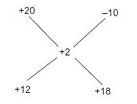Question:
A person spent Rs 50000 to purchase a desktop computer and a laptop computer. He sold the desktop at 20% profit and the laptop at 10% loss. If overall he made a 2% profit then the purchase price, in rupees, of the desktop is
A person spent Rs 50000 to purchase a desktop computer and a laptop computer. He sold the desktop at 20% profit and the laptop at 10% loss. If overall he made a 2% profit then the purchase price, in rupees, of the desktop is
Updated On: Jul 25, 2025
Hide Solution
Verified By Collegedunia
Approach Solution - 1
Using Alligation Rule, the ratio of cost prices of desktop and laptop will be

Let the total cost be ₹50,000.
We are told that the cost of the desktop is \(\frac{2}{5}\) of the total cost.
So, the cost of the desktop is: \[ \text{Cost of desktop} = \frac{2}{5} \times 50000 \] Now calculate the product: \[ = \frac{2 \times 50000}{5} = \frac{100000}{5} = 20000 \] ∴ The cost of the desktop is ₹20,000.
Was this answer helpful?
0
0
Hide Solution
Verified By Collegedunia
Approach Solution -2
Let D be the cost of the desktop and L be the cost of the laptop.
Step 1: Given equations
- From the statement: "0.2 times D minus 0.1 times L is equal to 2% of ₹50,000": \[ 0.2D - 0.1L = 0.02 \times 50000 = 1000 \tag{1} \]
- Multiplying equation (1) by 10 to eliminate decimals: \[ 2D - L = 10000 \tag{2} \]
- We are also given that the total cost of the desktop and laptop is ₹50,000: \[ D + L = 50000 \tag{3} \]
Step 2: Solving the system
Add equations (2) and (3):
\[ 2D - L + D + L = 10000 + 50000 \] \[ 3D = 60000 \] \[ D = \frac{60000}{3} = \boxed{20000} \]
Final Answer: \( \boxed{D = 20000} \)
Was this answer helpful?
0
0
Top Questions on Percentage
- A bought a phone from a store and paid \(\frac{1}{6}\) of the price using UPI, \(\frac{1}{3}\) of the price in cash, and the remaining balance a year later. He also paid 10% interest on the remaining balance after one year. What was the original price of the phone?
- What is the % growth in the total production from 2018 to 2021?
- A shopkeeper increases the price of an article by 25% and then offers a discount of 20%. What is the net percentage change in the price?
- A certain amount of money was divided among Pinu, Meena, Rinu, and Seema. Pinu received 20% of the total amount and Meena received 40% of the remaining amount. If Seema received 20% less than Pinu, the ratio of the amounts received by Pinu and Rinu is:
- In an exam, the ratio of boys to girls is 3:2. If 20% of the boys and 30% of the girls fail, what is the overall percentage of students who fail?
View More Questions
Questions Asked in CAT exam
- In a $\triangle ABC$, points $D$ and $E$ are on the sides $BC$ and $AC$, respectively. $BE$ and $AD$ intersect at point $T$ such that $AD : AT = 4 : 3$, and $BE : BT = 5 : 4$. Point $F$ lies on $AC$ such that $DF$ is parallel to $BE$. Then, $BD : CD$ is:
- CAT - 2025
- Geometry
- In the sequence 1, 3, 5, 7, ..., k, ..., 57, the sum of the numbers up to k, excluding k, is equal to the sum of the numbers from k up to 57, also excluding k. What is k?
- CAT - 2025
- Arithmetic Progression
- Find the number of integer pairs (x, y) that satisfy the following system of inequalities:
\[ \begin{cases} x \geq y \geq 3 \\ x + y \leq 14 \end{cases} \]
- CAT - 2025
- Linear & Quadratic Equations
- The monthly sales of a product from January to April were 120, 135, 150 and 165 units, respectively. The cost price of the product was Rs. 240 per unit, and a fixed marked price was used for the product in all the four months. Discounts of 20%, 10% and 5% were given on the marked price per unit in January, February and March, respectively, while no discounts were given in April. If the total profit from January to April was Rs. 138825, then the marked price per unit, in rupees, was
- CAT - 2025
- Profit and Loss
- An item with a cost price of Rs.1650 is sold at a certain discount on a fixed marked price to earn a profit of 20% on the cost price. If the discount was doubled, the profit would have been Rs.110. The rate of discount, in percentage, at which the profit percentage would be equal to the rate of discount, is nearest to:
- CAT - 2025
- Profit and Loss
View More Questions